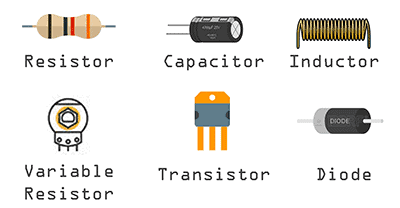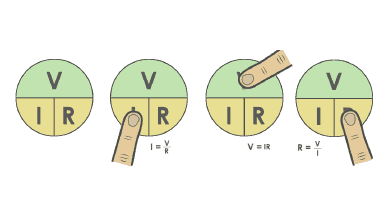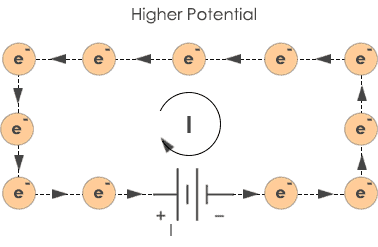There are many types of conductor and insulator used in electrical and electronic circuits. Substances covered with metal shields are the electrical conductors. In a conductor, electric current flows in the form of negatively charged electrons.
Whereas insulator is a material suitable for preventing the flow of electricity. They bypass or store charge and the flow of current will be lesser due to their electrical properties. But in some cases, the insulator conducts when subjected to the high potential difference.
In this tutorial, you will know the applications of conductive and insulating materials along with examples.
Examples of Conductors
Conductors are the metals that pass electricity freely and the examples of conductive materials are Copper, Aluminium, Brass, Graphite, Gold, Brass, Bronze, and Steel etc.
1. Copper
Copper is a conductive material having a low resistance. The electrons are loosely attached to a nucleus and flow freely. The energy losses in copper are less when compared with other conductive metals.
The property of high melting point makes the copper suitable for heating applications.
The copper has good thermal conductivity, electrical conduction, and corrosion resistant.
It can be recycled in many forms, tough and easy to the alloy. Copper has nonmagnetic properties, disinfectant, easily linked to other metals.
Here are some of the uses of Copper.
Applications of Copper
- Used in the household for electrical wiring and grounding other than aluminum.
- Used in Solenoid
- Electric Bells
- Water Pipes
- Electromagnets
- Locks
- Electric motors
- Cookware
- Power stations
- Transformers
- In electrical Cords
- Pipes and fitting
- Natural gas pipes
- Seawater
- Telecommunication
2. Silver
Silver withstands corrosion and provides oxidation. Hence, it is good for electrical usage. It is also used in medical applications for antimicrobial analysis.
It is a perfect metal for making jewelry and industrial pipes and fittings.
Applications of Silver
- Filmy photography
- Used as catalyst
- Jewels
- Used as contact with switches
- Automobiles
- In solar panels
- Soldering metals
- Used as a disinfectant for preventing wounds.
- For refining petroleum waste particles.
3. Aluminium
Aluminium is a metal utilized in electronics for its valuable mechanical electrical attributes.
They are used in making conductor pipes, motor assembly housing, and heat sinks.
Aluminium is used in various applications and areas such as:
Aluminium applications
- Antennae
- Telescopic Handlers
- Ladders
- Pharmaceutical coverings
Packaging Applications
- Metal packing
- Food and beverage drinking outlets
- Inclosure applications as screw caps for mineralized water, oils etc.
Foil Applications
Used in making coffee cups, nuts, chocolates, drinks etc.
4. Brass
Brass is used for electrical purpose due to its low cost. Some percentage of zinc is mixed with different proportions, making almost 15 types of brasses. Generally, Brass is one of the alloys of copper.
It is used for switches, connectors, contacts etc. The interesting thing is brass is a good metal for making musical instruments due to its acoustic and ductile properties.
5. Bronze
This is one of the copper alloys that contain lead, aluminum, silicon, and nickel. It is robust in nature when compared with brass.
It is corrosion resistant and flexible. Bronze is used in ball bearings, surgical instruments, and cast artifacts.
6. Iron
Iron is a good metal with shrinkable properties, damping capacity, fluid in nature.
Applications of Iron:
Cookware, manhole lids, Car parts, Bridges, metro buildings. It is a core element in building generators, motors, transformers, Audio and video storage devices etc.
Permanent magnets made of iron are used in MRI medical application.
7. Mercury
Mercury is a metal used in various electronic products. It is used in thermometers, light switches, Thermostatic devices (probes, heating and cooling systems), and vehicles.
Electronic medical devices like blood pressure meter use mercury.
Some of the sensors like Barometer, Hygrometer and Hydrometer use mercury for their operation.
8. Gold
Electronic devices make use of gold coating for eliminating corrosion. It is a good resource for manufacturing electronic components. Gold is used in soldering joints, switches, electrical contacts.
Gold is used in mobile phones, GPS modules, PDA’s, Digital calculators, Smart TVs etc.
Application areas of gold include medical diagnostic equipment, satellite components and mechanical parts in aerospace industry etc.
9. Platinum
Platinum as a conductor used as an alternative to gold. It is used in electrical switches and contacts for preventing corrosion.
Applications of platinum include chemical processing (as a catalyst), Glass industry for making dyes, and extracting crude oil from petroleum.
10. Graphite
Graphite is used as a semiconductor for making monocrystalline integrated chips. It is used for making electrodes for plasma engraving.
It is used in ion implantation, fiber optics, surface tiles in space shuttles, and in cryogenic application designs.
Automotive cars use graphite for electrical motors and generator components, in bearing elements, and in braking systems.
In defense, graphite is used as an important element for building weightless components. Some of them are the wheel and tracking vehicles, unmanned ships, and airborne missiles.
11. Insulator
The Insulator is a material that retards the flow of electricity. There are different insulators used in the electrical and electronic component and assemblies. Some of the insulators are Porcelain, plastic, ceramic, polymer etc.
Examples of Insulators
- Porcelain
It is a material that resists electrical current at eminent temperature. Porcelain has good dielectric strength, anticorrosive.
Porcelain metal is desirable for tension applications (high and low). It is widely used in chemical processing industries.
Used in dental restoration applications, lab applications, microwave ovens etc.
- Plastic
Plastics do not conduct electricity and hence it is the best insulator for various applications. They have widely used household goods like lights, hair dryers, vacuum cleaner, washing machine, refrigerator and many more.
Plastics are used for electrical insulation and wiring shields. They are also employed for heat insulation requirements. They are used in toasters, fat roasters, coffee kettles, switches, vending machines etc.
- Ceramic
This material is used in areas like textiles, aerospace, electrical, electronics, mechanical and many more.
Ceramic is used in high-temperature devices, electrical appliances, thin film circuits, heating elements, microwave ovens etc.
They are used in high speed spindles for cutting the PCBs (Printed Circuit boards), brushless motors, vehicle electrical, and heat exchangers etc.
They are also used in healthcare (medical components and sensors), pacemakers, dental, hearing and medical implants etc.
- Fiber Glass
Fiberglass uses reinforced plastic used in various applications. There are different types of glass fiber.
Fiberglass is used in Beverage for bottling lines, aerospace, marine industry, automotive, electronics and medical applications.
It is also used in food processing and automotive electronics.
- Quartz
Quartz is a material used for cutting the diamond crystals. It is the primary element in making watches and semiconductor. Grinding machines employ quartz for milling and crushing. Electronic circuits like VCXO, TCXO oscillators use quartz for generating frequencies. Moreover, it is also used to separate out wanted and unwanted frequencies.
- Mica
Mica is an ore used as an electronic insulator, in paints, to eliminate dust and welding rods.
It is the best insulator used in fire extinguisher, pipe insulation, roofing industry, gaskets, sports equipment, and also for making microscopic samples.
The flow of electricity depends on the material and metal used in semiconductors, conductor, and an insulator. Hence, proper selection of conductor and insulator is required based on the metallic properties.




It was pretty useful. I used it for my physics project.
Thanks!
It was very helpful in.my school sac work😆😀